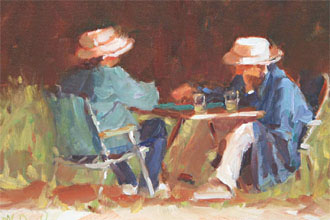|
| Magriel's NYT Columns |
 The experienced player will always take advantage of a superior position to extract the maximum number of points from the game.
The experienced player will always take advantage of a superior position to extract the maximum number of points from the game.
One player used this notion in the diagrammed position, even though the outcome appeared set.
Black has a virtually certain victory but seemingly little chance for a gammon. As it stands, Black has nothing to fear. No matter what White rolls, there is no way he can escape from behind Black’s 6-point prime, or blockade. Because White is stuck behind Black’s prime, Black, barring accidents in the bearoff, will easily win the race.
|
| Black to play 5-2. |
Why does Black risk losing a game he has all but won? After all, by breaking his prime, Black gives White a chance to escape with a 6. Indeed, should White happen to roll double 6’s (a 35-to-1 shot), White will play 1/13(2), escaping with both back men, and will so instantly reverse the anticipated outcome of the game.
In all probability, however, Black’s “trap play” will produce a different result. If White rolls only a single 6 on one die and any other number on the other die, he will be forced to break his anchor on the 1-point and move one man out. Then White’s two back men will be isolated and exposed. Black will be able to attack these men and may close both of them out. (White, with only a 3-point home board, is particularly vulnerable.)
Now Black’s objective in breaking his prime becomes clear. By luring White off his 1-point, Black can close White out, giving himself significant gammon potential. If Black begins bearing off while White is still entrenched on the 1-point, experience has shown that his gammon possibilities are remote. But if Black begins bearing off while White has two men on the bar, his gammon possibilities are almost 50–50.
Sometimes in backgammon it pays to be greedy. When you need only take a small risk of losing a game for the sake of winning a gammon, incurring the small risk may be worthwhile. In this case, it is 10 times more likely that White will roll a single 6 to emerge with only one man than it is that he will roll double 6’s.
Rollout
 Tom Keith 2013 |
|
Money play White owns 2-cube Black rolls 5-2 1296 games with VR Checker play: 2-ply Cube play: 3-ply Red |
| 5-2: | Game | G | BG | Equity | ||||
| 1 | 7/5, 7/2 |
W L |
.9228 .0772 |
.1787 .0009 |
.0043 .0000 | +1.0029 |

| |
| 2 | 18/11 |
W L |
.9328 .0672 |
.1422 .0004 |
.0031 .0000 | +0.9883 | (0.0146) |

|
|

